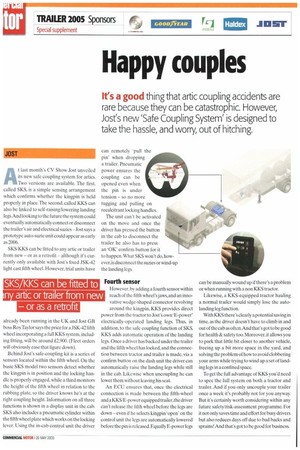Happy couples
Page 78

If you've noticed an error in this article please click here to report it so we can fix it.
It's a good thing that artic coupling accidents are rare because they can be catastrophic. However, Jost's new 'Safe Coupling System' is designed to take the hassle, and worry, out of hitching.
At last month's CV Show Jost unveiled its new safe coupling system for artics. Two versions are available. The first, called SKS, is a simple sensing arrangement which confirms whether the kingpin is held properly in place. The second, called KKS can also be linked to self-raising/lowering landing legs. And looking to the future the system could eventually automatically connect or disconnect the trailer's air and electrical suzies -Jost says a prototype auto-suzie unit could appear as early as 2006.
SKS/KKS can be fitted to any artic or trailer from new or as a retrofit although it's currently only available with Jost's fixed JSK-42 light cast fifth wheel. However, trial units have already been running in the UK and Jost GB boss RoyTaylor says the price for a JSK-42 fifth wheel incorporating a full KKS system. including fitting, will be around 0,900. (Fleet orders will obviously ease that figure down).
Behind Jost's safe-coupling kit is a series of sensors located within the fifth wheel. On the basic SKS model two sensors detect whether the kingpin is in position and the locking handle is properly engaged, while a third monitors the height of the fifth wheel in relation to the rubbing plate, so the driver knows he's at the right coupling height. Information on all three functions is shown in a display unit in the cab. SKS also includes a pneumatic cylinder within the fifth wheel plate which works on the locking lever. Using the in-cab control unit the driver can remotely 'pull the pin' when dropping a trailer. Pneumatic power ensures the coupling can be opened even when the pin is under tension so no more tugging and pulling on recalcitrant locking handles.
The unit can't be activated on the move and once the driver has pressed the button in the cab to disconnect the trailer he also has to press an 'OK' confirm button for it to happen. What SKS won't do, however,is disconnect the suzles or wind-up the landing legs.
Fourth sensor However, by adding a fourth sensor within reach of the fifth wheel's jaws, and an innovative wedge-shaped connector revolving around the kingpin. KKS provides direct power from the tractor to Jost's own `E-power' electrically-operated landing legs. Thus, in addition, to the safe coupling function of SKS, KKS adds automatic operation of the landing legs. Once a driver has backed under the trailer and the fifth wheel has locked, and the connection between tractor and trailer is made, via a confirm button on the dash unit the driver can automatically raise the landing legs while still in the cab. Likewise when uncoupling he can lower them without leaving his seat.
An ECU ensures that, once the electrical connection is made between the fifth-wheel and a KKS/E-power equipped trailer,the driver can't release the fifth wheel before the legs are down even if he selects kingpin 'open' on the control unit the legs are automatically lowered before the pin is released. Equally E-power legs can be manually wound up if there's a problem or when running with a non IUCS tractor.
Likewise, a KKS-equipped tractor hauling a normal trailer would simply lose the autolanding leg function.
With KKS there's clearly a potential saving in time, as the driver doesn't have to climb in and out of the cab as often.And that's got to be good for health & safety too. Moreover, it allows you to park that little bit closer to another vehicle, freeing up a bit more space in the yard, and solving the problem of how to avoid clobbering your arms while trying to wind up a set of landing legs in a confined space.
To get the full advantage of KKS you'd need to spec the full system on both a tractor and trailer. And if you only uncouple your trailer once a week it's probably not for you anyway. But it's certainly worth considering within any future safety/risk-assessment programme. For it not only saves time and effort for busy drivers but also reduces days off due to bad backs and sprains! And that's got to be good for business.












































































































































































































































